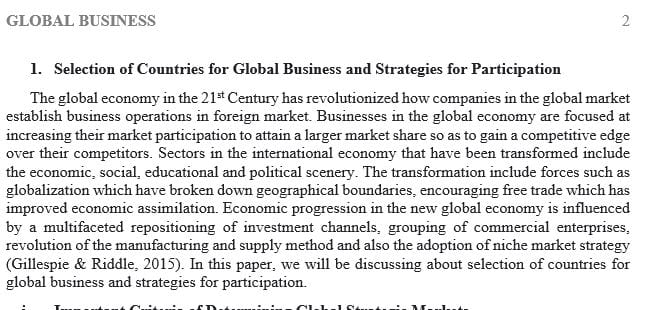Selection of Countries for a Global Business and Strategies for Participation
1. Selection of Countries for a Global Business and Strategies for Participation
“Instead of selecting country-markets on the basis of stand-alone attractiveness, managers need to consider how participation in a particular country will contribute to globalization benefits and the global competitive position of the business.” Being a serious global player means much more than simply having X percent of your revenues from outside the USA and being involved in Y number of countries. “Being present in ten countries that include the United States, Japan, and Germany is far more important, in most industries, than is being present in thirty countries that exclude these three but include many small, less advanced countries…To have a global level of market participation requires significant global market share, a reasonable balance between the business’s geographic spread and the market’s spread, and presence in globally strategic country-markets.”
(i)What are the most important criteria for determining what are, and what are not, globally strategic markets? Please describe these criteria in detail and provide some relevant examples.
(ii)What are the specific benefits to the firm of participating in globally strategic markets? Please describe these benefits.
(iii)How should the changes associated with the phenomenon of globalization influence firm decisions regarding selection of countries for participation? What changes should firms actively monitor and how should firms interpret them?
2. Activity Location in the Global Value Chain
Each functional or value-adding activity, from R&D to manufacturing to customer service is a candidate for globalization under a strategic approach implemented with a global mindset. Thus the firm should configure each stage of its value chain at the most appropriate location worldwide in terms of minimizing system costs and maximizing system revenues. It should then optimally coordinate the activities at these disparate locations for maximal organizational benefit. Where to locate all the activities in the firm’s value chain reflects a trade-off between traditional country considerations and the global strategic importance of each location. Thinking about the competitive or strategic advantages a firm might possess versus the comparative advantages that might be present in a particular location:
(i) First, please define these two concepts and describe the origins of each.(ii) How might the firm go about combining these two advantages in order to achieve optimal, organizational results in terms of increased profits, competitive advantages, and so forth?
(iii) In reality, most companies have some duplication of their value chain in each of the countries where they do business. Why would having a certain amount of duplication be an advantage to the firm? Please elaborate.
(iv) Research and development is a critical function for most firms. For the global firm, what factors should be considered when deciding where to locate the R&D function?
Please describe each of these briefly. Which of these factors do you think is most important for computermanufacturers such as Dell and Toshiba, and why?
Solution preview for the order on selection of Countries for a Global Business and Strategies for Participation
APA
2885 words
